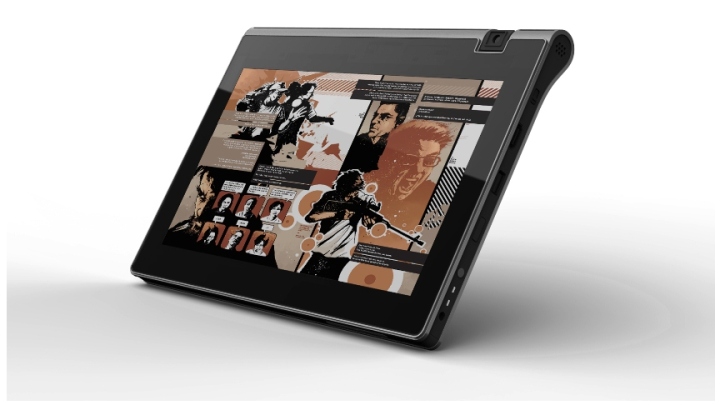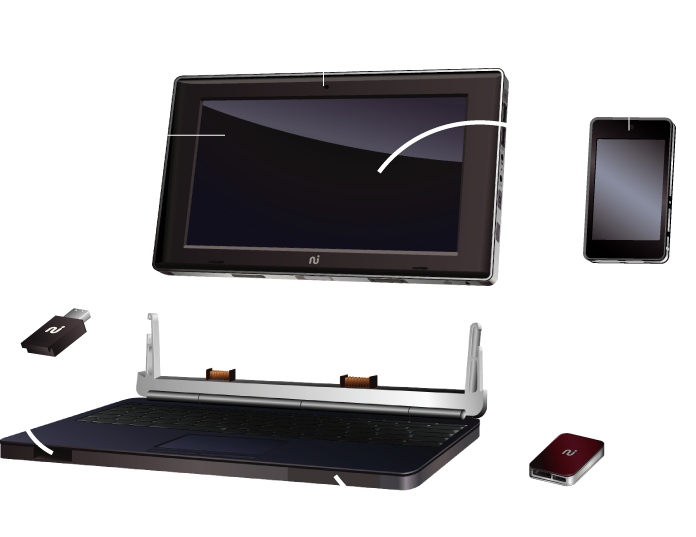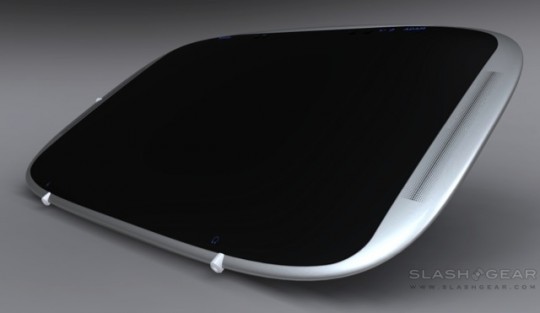We can safely say that the Apple iPad is received with mixed feelings by the IT-savvy community. The main problem is that the tablet is just not as revolutionary as many expected it would be. It keeps many of the limitations of the iPhone (no multitasking, tightly controlled app-store) and doesn't provide impressive new features which could keep the balance.
Let's compare this tablet to one of the more promising Tegra 2 tablets on the way to the market: the Notion Ink Adam. Admittedly, the Adam is not on the market yet, while the iPad is quite sure gets there soon. Nevertheless, we give the benefit of the doubt to Notion Ink (especially, considering how badly Nvidia wants to start the Tegra 2 device line). In my comparison, the Adam runs Ubuntu Linux with the
Mobile Edition which has a touch oriented user interface. The first version of the Adam is expected to come with Android but since Nvidia
officially supports Ubuntu on the Tegra 2, we can expect a fully working Ubuntu edition on the Adam soon enough. Moreover, for such powerful hardware as the Adam, even Android seems limited to me.
Screen technology and diplay features
Both the iPad and the Adam have ~10" LCD displays with capacitive touchscreen technology. However, the Adam features PixelQi technology which means lower power consumption, direct sunlight readability and higher contrast when switched to BW mode for reading. The Adam will have a hardware switch for easy mode-changing (BW/low-power colour/full colour) which will help lowering the power consuption (like a wifi or 3G radio shut-off switch). The iPad doesn't seem to have any hw switch, not even one for adjusting the brightness of the screen (meaning: unless there is an ultra-easy touch gesture for it, nobody will adjust the brigthness for ambient light conditions). The iPad specs page lists an ambient light sensor, so the OS may be able to automatically turn-down the backlight when not needed but this won't save you as much as the power saving modes of the PixelQi screen. All-in-all, the screen of the Adam seems to be more versatile and power efficient.
Processing powerThe custom Apple A4 processor of the iPad runs at 1Ghz and is a single-core ARM Cortex A9 solution. The Tegra 2 of the Adam features 2 Cortex A9 cores running at 1 Ghz. Due to the exact same technology platform, I expect the Adam almost two times as powerful as the iPad and this should be very much noticable in the more important applications (e.g. web-browser). The iPad has the stock ARM Mali 50 graphics core, while the Tegra 2 includes a Geforce 9 level graphics core. Although, I am not very familiar with the capabilities of these cores, I expect the Nvidia core to be more powerful since this is where Nvidia has strong competency. Some say the Mali core is not even in the same league as the Tegra 2 graphics core but this remains to be seen. (Disclaimer: it is possible that current reports about the inclusion of the Mali are inaccurate and the iPad uses a PowerVR graphics core like the iPhone).
GUI/desktop enviromentThe iPad runs the GUI environment of the iPhone OS (an OS X derivative), while the Adam runs Ubuntu Mobile (at least in my comparison). The Adam may not support multitouch in the short term but already has support for gestures (e.g: a swipe for moving to the next image in the image browser). The iPad supports multitouch and a wide array of gestures. I expect the iPad GUI easier to use and more refined (at least for the time being, since Ubuntu Mobile is quite a young project).
The "desktop" is easy to use in both environment, very similar application startup and indicators. The Ubuntu OS will run several applications in parallel while you will be able to use only one app ata time on the iPad. (see about this later)
Web Browsing
The iPad doesn't run Flash but said to render normal webpages snappily in its custom Safari browser. Youtube is supported just like on the iPhone but no Flash games and no Java applets in webpages (see about interpreters later in the application section).
The Adam will run full editions of Firefox/Chrome/Opera and expected to have an optimized Flash version (Flash 10.1 coming soon) so it will be good for running web-pages with video streaming and Flash games. Java applets (rare nowadays) will work too.
Playing video / Listening to musicThe iPad has no HDMI output (has a simple VGA output, max res: 1024x768) and is rated for decoding 720p videos. This is a far cry from the 3 simultanious 1080p streams of the Tegra 2 and built-in HDMI port of the Adam. The Tegra 2/ Adam offering is far more powerful and makes the Adam a viable HTPC if you want to play the movies from your tablet onto your HDTV screen.
Both have a 3.5 mm jack and speakers so hw-wise, listening to music should not be a problem. Ubuntu has powerful music player applications which are on par with iTunes of the iPhone/iPad.
Playing gamesThe Geforce graphics core of the Tegra 2 in the Adam will be quite sufficient to play 3D games. The performance of the Mali 50 is not widely known at this point but is not expected to be worse than the graphics core in the iPhone 3GS so it is likely able to run 3G games like the demo based on the Unreal engine. I expect the Tegra 2 graphics core of the Adam more powerful.
Camera / video chat / VOIP
The iPad doesn't have a built-in camera which is a glaring omission. The Adam will have a 3Mp built-in camera, which is more than enough for Skype videophoning. Moreover, the Tegra 2 supports real-time hardware encoding of 1080p streams to H264 so, properly written video-chat applications should work extremely well on the Adam. Ubuntu should run any Linux VOIP app compiled for ARM. I expect Skype and other open/closed source software work well on the Adam in the short-medium term.
Apple has recently lifted the restrictions on Skype and other VOIP apps in the iPhone app catalog so the iPad will have the voice part OK but you will need an external cam for video chats and currently there is no information on the video encoding capabilities of Apple's A4 SOC.
Battery runtimeThe iPad is rated for 10hrs of use (wifi browsing). The Adam is specified to have 16 hours of wifi browsing. The Adam looks like the winner here but the iPad's 10-hour runtime is also quite good.
Ebook readingThe Adam's PixelQi screen supports this activity much better especially in sunlit places. Ubuntu runs FBReader (my favourite ebook reader software) and has viewers for every kind of complex-document formats (most of them will be displayed in Evince, in case of Ubuntu). The iPad has a new reader application which is too early to write about but expected to be an intuitive reader-app (if the track record of Apple is any indication).
NavigationBoth devices include GPS units, so navigation software should be available for both. Google Navigation will certainly run on the Adam, I just hope it doesn't get blocked from the iPad app-store.
Other applications, Multitasking
While the iPhone has a huge selection of applications in Apple's app-store, most of them will have to be tailored for the iPad for full potential. This will surely happen if the iPad becomes successful but it may happen slowly if the device proves to be less than a clear success. Application-wise, I expect the Apple iPad to be as closed as the iPhone, so you will be able to install only Apple-approved applications from the official app-store.
Ubuntu on the Adam can run any full-desktop or command line Linux/ARM software from the Ubuntu ARM repositories. This is a huge selection of software and includes powerful applications like OpenOffice, GIMP and others. These may not be optimized for the touchscreen interface but the Adam's backside trackpad can help using them in tablet mode and in docked mode you will be able to use a USB mouse and keyboard just like with a netbook. Moreover, Ubuntu is completely free of limitations so you will be able install whatever software you want.
The iPad currently has multitasking disabled so you can run only one application at a time. The Adam has the full multitasking of Linux. The Adam's dual-core hardware should run several applications efficiently in parallel. A good use-case for this: a Bittorrent download running on your Adam while reading an ebook (I do this quite often on my OLPC XO-1).
Apple doesn't allow applications running in interpreters so you will never run a Flash/Java/Python/.Net-Mono application on the iPad although the hardware is sufficient for them. The Adam's Ubuntu will run any of those applications without any restrictions. Flash 10.1 is expected to be optimized for ARM SOCs and Java 6 has an optimized version for the Cortex A9 processors so the Adam should run apps based on these technologies well. Desktop and Webstarted Java clients are quite common in the enterprise IT world so the Adam may get some love from there.
It is not yet known how much RAM the iPad or the Adam has, but based on the Tegra 2 development board, the Adam will have at least 1 Gb of RAM which is quite sufficient for running even several complex applications in parallel.
StorageThe Adam will have expandable storage by a microSD slot, while the iPad seems to have no storage expansion slot at all.
PriceThe cheapest version of the iPad is announced for $499 in the US. The Adam is expected to carry a sub-$400 pricetag ($320 is a current estimate).
ConclusionThe iPad hardware seems to be seriously lacking when compared to the Adam's Tegra 2 foundations, PixelQi screen, trackpad and other features.
Application-wise, the playground is more leveled but for Linux-savvy people the choice is a no-brainer. The iPad will certainly appeal to people who want devices which "just work" and accept the serious, artificial limitations imposed on their device.
Reference:iPad specifications by AppleUbuntu Mobile Edition




